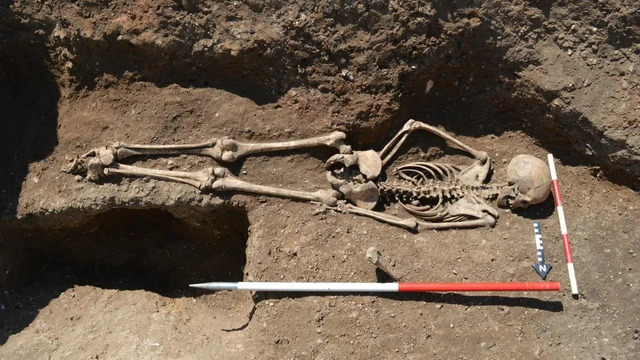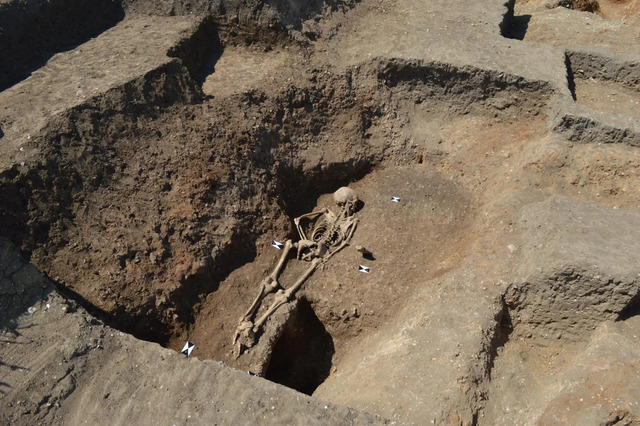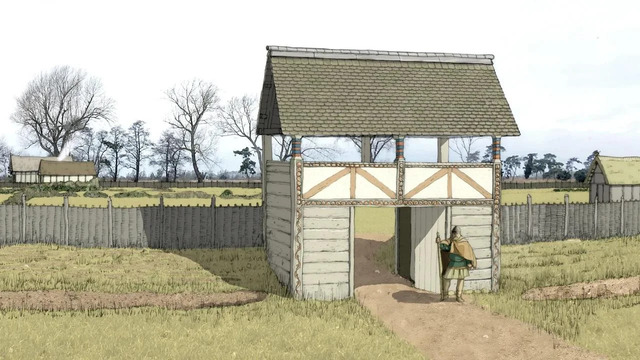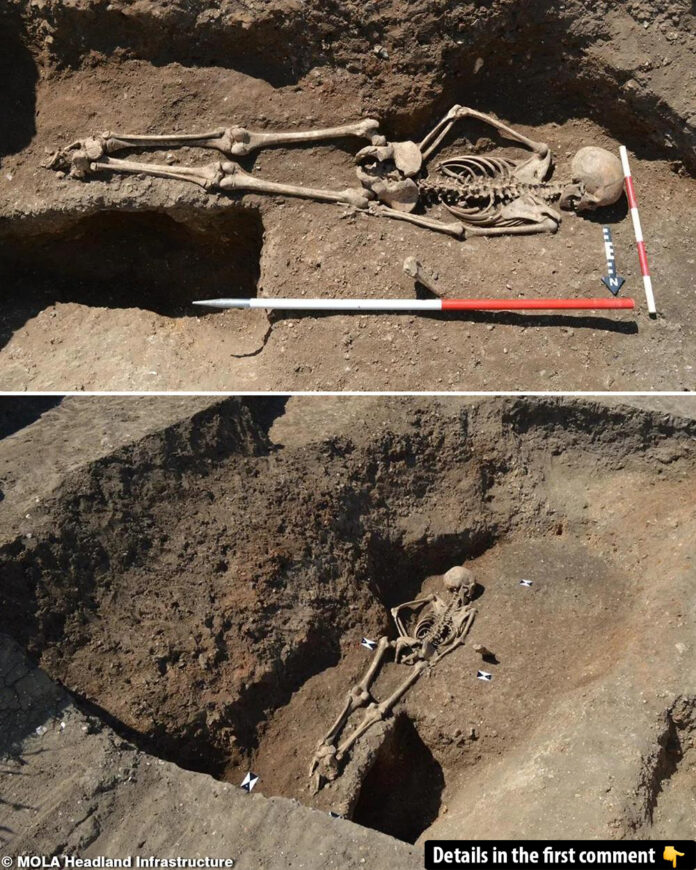An extraordinary archaeological discovery in Conington, Cambridgeshire, has unveiled a story of mystery, superstition, and societal dynamics in Early Medieval England. Unearthed between 2016 and 2018, the burial of a 15-year-old girl, face down and potentially bound at the ankles, challenges conventional burial practices of the time. This fascinating find provides a glimpse into the beliefs and customs of the Anglo-Saxon community, shedding light on their fears, social norms, and the significance of boundaries in burial rituals.
Discovery and Excavation
The excavation, conducted as part of a national highway improvement project, revealed a settlement near Conington that served as an administrative hub during the Kingdom of Mercia. Among the finds was a pit containing the skeletal remains of a teenage girl buried face down—a stark contrast to the upward-facing burials that were customary during the period. Her position, combined with the possible binding of her ankles, suggests deliberate measures taken by the community. Radiocarbon dating places her death between CE 680 and 880, aligning with the Early Medieval era.

Led by the Museum of London Archaeology (MOLA) and MOLA Headland Infrastructure, the excavation uncovered evidence of social and cultural practices that shaped the lives of this community. The girl’s burial, discovered near the remnants of a settlement gate post, offers a rare insight into the complexity of beliefs during this turbulent period in England’s history.
Discover why people were buried face down in medieval times – watch the video to uncover the historical and cultural reasons behind this eerie burial practice!
Unique Burial Practices
The face-down burial of the Conington girl stands out as a remarkable deviation from typical Early Medieval practices. Such positioning has been interpreted by archaeologists as an expression of “otherness,” signifying that the deceased was perceived as different or potentially dangerous. The potential binding of her ankles further supports the idea that this burial was designed to prevent the girl from rising from the grave—a reflection of deep-seated fears and superstitions held by the community.
Similarities can be drawn to later instances of so-called “vampire burials,” which became more common during the 14th to 17th centuries. While these burials often involved measures like placing heavy stones over the body or decapitation, the Conington discovery suggests that such fears may have roots in earlier periods. This practice underscores the persistent anxiety surrounding the possibility of the dead returning to harm the living.

Significance of the Burial Location
The placement of the girl’s grave in a pit that once held an entry gate post adds another layer of complexity to the find. During the Early Medieval period, boundary areas such as gates, ditches, or borders were often chosen for “unusual” or symbolic burials. These locations, on the periphery of the community, held a liminal quality, signifying the transition between the known and the unknown.
This particular burial aligns with another face-down interment discovered roughly 30 miles away, further supporting the idea that boundaries carried special significance in Anglo-Saxon burial practices. As the Conington settlement was abandoned around the time of the girl’s burial, her placement near the gate post may symbolize a closure of the site and the waning power of the Kingdom of Mercia.
Social Status and Health of the Deceased
The analysis of the girl’s skeletal remains offers valuable clues about her life and social standing. Evidence of childhood malnutrition and a spinal joint disease suggests that she likely belonged to a lower social stratum. These findings reflect the harsh realities of life for many during the Early Medieval period, where poverty and limited resources were prevalent.
Interestingly, the absence of signs of prolonged illness on her bones points to a sudden or unexpected death. This abrupt end, coupled with her unusual burial, raises questions about how her community viewed her life and demise. Was she an outcast, or did her death provoke fear among the living?
Superstitions and Community Beliefs
The Conington burial reveals the complex relationship between Early Medieval communities and their beliefs about death and the afterlife. The fear that the dead might return to harm the living is a theme echoed in various cultures and periods, often manifesting in burial practices designed to “secure” the deceased.
The potential binding of the girl’s ankles and her face-down position suggest that the community may have viewed her as a threat, either due to her perceived otherness or the circumstances of her death. Such measures reflect not only superstition but also the community’s efforts to maintain order and protect itself from perceived dangers.
Historical Context of the Settlement

Conington’s settlement played a significant role in the Kingdom of Mercia, one of the most influential Anglo-Saxon realms. Serving as an administrative center, the site reflects the organizational structure and political power of the kingdom. However, by the time of the girl’s burial, the settlement was in decline, mirroring the waning influence of Mercia as a whole.
The burial’s timing suggests a symbolic closure of the site, marking the end of an era for the community. This poignant farewell highlights the intersection of personal, social, and political narratives within the archaeological record.
Video
Archaeologists have uncovered a massive Anglo-Saxon and Bronze Age cemetery – watch the Time Team Chronicle video to explore this incredible find and its ancient secrets!
Conclusions and Implications
The discovery of the Conington girl’s burial is a testament to the power of archaeology to uncover hidden stories of the past. Her face-down position, bound ankles, and placement near a settlement boundary reveal much about the beliefs, fears, and social dynamics of Early Medieval England.
This remarkable find challenges us to reconsider the complexity of burial practices and the cultural significance of boundaries. It also underscores the importance of archaeological research in illuminating the lives of those who lived in the shadows of history.
As we continue to explore the Conington site and similar discoveries, we gain a deeper understanding of how communities navigated the challenges of life and death, forging connections across time that enrich our understanding of humanity’s shared past.
